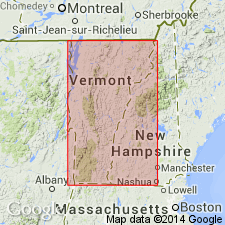
- Usage in publication:
-
- Brandon deposit
- Modifications:
-
- Original reference
- AAPG geologic province:
-
- New England province
Summary:
E. Hitchcock, v. 1. The Brandon deposit is the type of a Tertiary formation hitherto unrecognized as such, extending from Canada to Alabama. Probably belongs to Pliocene.
Source: US geologic names lexicon (USGS Bull. 896, p. 251).
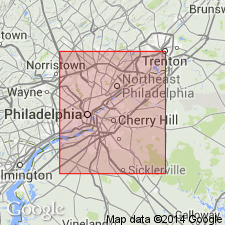
- Usage in publication:
-
- Brandon period
- Modifications:
-
- Age modified
- AAPG geologic province:
-
- New England province
Summary:
Pg. 282-291, 297. Brandon period. Is possibly Oligocene. The lignite at Brandon, Vermont, lies in beds of plastic clay, kaolin, and iron ore. Contains fossil plants.
Source: US geologic names lexicon (USGS Bull. 896, p. 251).
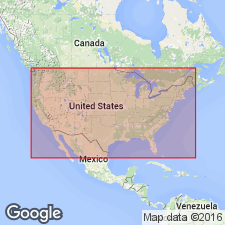
- Usage in publication:
-
- Brandon formation
- Modifications:
-
- Revised
- Age modified
- AAPG geologic province:
-
- New England province
Summary:
Pg. 90-93. Under name Brandon formation are included the lignitic beds of Vermont, Pennsylvania, and Georgia, deposits whose taxonomy has not yet been definitely determined, but which may provisionally be referred to Eocene.
Source: US geologic names lexicon (USGS Bull. 896, p. 251).

- Usage in publication:
-
- Brandon lignite
- Modifications:
-
- Areal extent
- AAPG geologic province:
-
- New England province
Summary:
Pg. 43-55. Brandon lignite. Tertiary is exposed in Brandon only, but without doubt is more widely distributed in Vermont, but has been deeply covered by Pleistocene.
Source: US geologic names lexicon (USGS Bull. 896, p. 251).

- Usage in publication:
-
- Brandon lignite
- Modifications:
-
- Biostratigraphic dating
- AAPG geologic province:
-
- New England province
Summary:
Pg. 211-216. Brandon lignite. Evidence is sufficiently weighty to justify considering Brandon lignite and its contained flora as Eocene.
Source: US geologic names lexicon (USGS Bull. 896, p. 251).
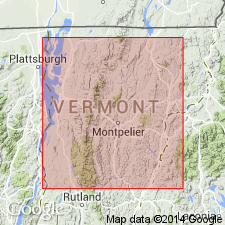
- Usage in publication:
-
- Brandon lignite
- Modifications:
-
- Age modified
- AAPG geologic province:
-
- New England province
Summary:
Table opp. p. 288. Assigned Brandon lignite to Miocene.
Source: US geologic names lexicon (USGS Bull. 896, p. 251).
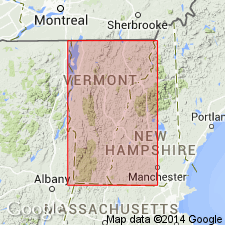
- Usage in publication:
-
- Brandon residual formation
- Modifications:
-
- Revised
- AAPG geologic province:
-
- New England province
Summary:
Pg. 115-135. Brandon residual formation. Kaolin, ocher, sands, lignite, and iron ores, 0 to 175 feet thick. Extends through western tier of counties from Colchester on north to Massachusetts line on south. Lies in Vermont Valley between Green Mountain Range on east, and Taconic Mountains on west. It is unfortunate that Brandon has been used to denote both this entire formation and also its lignite member. The rock materials included under Hitchcock's and Clark's term Brandon formation are kaolin, ocher, quartz sand, nodular and concretionary iron ores, manganese ore, and lignite, all, with exception of the lignite and manganese ore, residual products of rock decomposition. In endeavor to find a handle to apply to the group which will not involve the error implied by calling them a formation, writer proposes compound word residual formation, and will hereafter refer to them as Brandon residual formation. The only place in State where all of members are known to be present is in old lignite mining area east of Brandon. The formation is Tertiary, and its age has been established as Miocene by Lesquereux, Knowlton, and Perkins.
Source: US geologic names lexicon (USGS Bull. 896, p. 251).
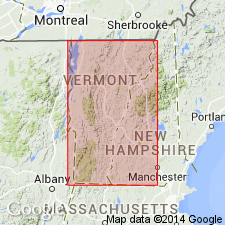
- Usage in publication:
-
- Brandon lignite
- Modifications:
-
- Areal extent
- AAPG geologic province:
-
- New England province
Summary:
Pg. 7-27. Tertiary clays extend from Colchester to Bennington; include Brandon lignite.
Source: US geologic names lexicon (USGS Bull. 896, p. 251).

- Usage in publication:
-
- Brandon lignite
- Modifications:
-
- Age modified
- AAPG geologic province:
-
- New England province
Summary:
Brandon lignite. The flora is Eocene according to E.W. Berry.
Source: US geologic names lexicon (USGS Bull. 896, p. 251).
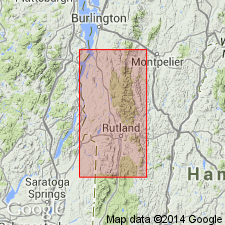
- Usage in publication:
-
- Brandon Lignite
- Modifications:
-
- Age modified
- AAPG geologic province:
-
- New England province
Summary:
Age of Brandon Lignite, a small organic deposit within a kaolinitic clay and silt sequence just south of Forestdale, VT, here modified in age to middle Cretaceous. "Previous age assignment of Oligocene based on incorrect and unsupportable assumptions." New age assignment, derived from a consideration of paleobotanical-paleomagnetic evidence, is consistent with surrounding geology. Brandon probably deposited at approximately the present latitude of AL anywhere from 130 to 100 m.y. ago. Overlies Cambrian strata and underlies Pleistocene glacial deposits.
Source: GNU records (USGS DDS-6; Reston GNULEX).

- Usage in publication:
-
- Brandon lignite
- Modifications:
-
- Age modified
- AAPG geologic province:
-
- New England province
Summary:
Authors describe the Brandon as an informal unit of kaolinitic clays, organic clays and lignite that occurs near the village of Forestdale, VT. Sediments are unlithified and unconformably overlie the contact of the Cambrian Cheshire Quartzite and Dunham Dolomite. They underlie Pleistocene drift. Mining records indicate that the deposit is about 9 km long, 40 m wide, and extends to at least a depth of 67 m. The Brandon lignite contains the most diverse Cenozoic angiosperm flora (wood, pollen, fruits, and seeds) in eastern North America north of MD. Based on available palynological and macrofloral evidence, the deposit is now felt to most likely be early Miocene in age. Authors discount the proposed Cretaceous age of Stockwell and Washington (1990) who based their assignment, in part, on Traverse's 1955 generic modernization curve. That curve for the Cretaceous was proved to be in error by Wolfe and Barghoorn (1960). The updated generic modernization curve offers no support to a possible Cretaceous age. Also, in advocating plate motion as the source of climatic change, Stockwell and Washington did not consider the possibility of global climatic change, which is a well accepted theory. As another argument, the authors state that the Brandon flora is totally different from the palynofloras of the Potomac Group of DE and MD, which are known to be Cretaceous.
Source: GNU records (USGS DDS-6; Reston GNULEX).
For more information, please contact Nancy Stamm, Geologic Names Committee Secretary.
Asterisk (*) indicates published by U.S. Geological Survey authors.
"No current usage" (†) implies that a name has been abandoned or has fallen into disuse. Former usage and, if known, replacement name given in parentheses ( ).
Slash (/) indicates name conflicts with nomenclatural guidelines (CSN, 1933; ACSN, 1961, 1970; NACSN, 1983, 2005, 2021). May be explained within brackets ([ ]).

